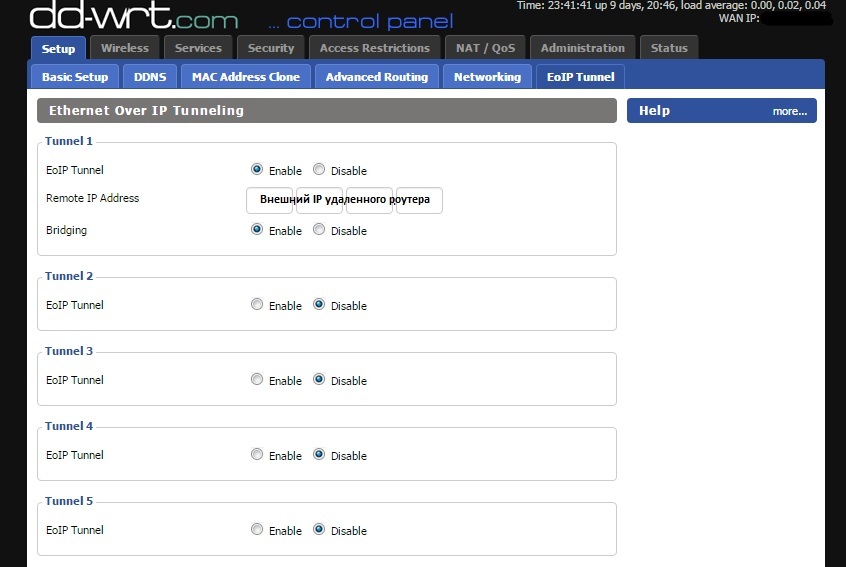EOIP & DD-WRT for combining two apartments in one network or all for Remote Play
Background:
Actually, the task is to combine house 1 and house 2 into one network with walking broadcasts and multicasts.
The goal is to make the PlayStation TV connect to the PlayStation 4 (without the main acc.) And make full use of Remote Play locally.
We have the following hardware in service:
House 1:
Dlink dir615C2
House 2:
Dlink dir615E4
Preparation, solution:
On both routers, firmware from dd-wrt was installed. The installation procedure is simple, there is a lot of information on the Internet on this topic.
For EOIP to work, it is necessary that there is a “white” IP address on both sides, which is purchased from the provider for 100 + rubles. If this is not possible, then you can forward the vpn tunnel (which I talked about in a previous publication), and run EoIP on top of it.
In order for users on both sides to see each other in a networked environment, it is necessary that they belong to the same local network. I used the following settings:
Network: 192.168.100.0/24
House 1: the router (192.168.100.10) has a pool of 192.168.100.1-192.168.100.50.
House 2: the router (192.168.100.70) has the pool 192.168.100.51-192.168.100.100
After we installed dd-wrt on our hardware and configured on each DHCP, connected the clients, and made sure of their work, we started creating the EOIP tunnel.
To do this, go to the web. router interface, go to the tab Setup-> EoIP Tunnel
Put EoIP Tunnel to position the Enable ;
In the Remote IP Address column, enter the external IP of the router (in the case of VPN, then specify the IP in the vpn tunnel) to which we must connect;
Bridging to Enable ;
* Mandatory, the tunnel numbers must match on both routers.

You can check the result in the web interface of the router by going to the Administration -> Commands tab :
in the Commands field, write ifconfig and click Run Commands . After which we will be given raised interfaces, among which will be our oet1.
Now we have an EOIP tunnel that allows not only to see shared folders on the network, but also send video from the phone to the TV in another apartment.
Actually, the task is to combine house 1 and house 2 into one network with walking broadcasts and multicasts.
The goal is to make the PlayStation TV connect to the PlayStation 4 (without the main acc.) And make full use of Remote Play locally.
We have the following hardware in service:
House 1:
Dlink dir615C2
House 2:
Dlink dir615E4
Preparation, solution:
On both routers, firmware from dd-wrt was installed. The installation procedure is simple, there is a lot of information on the Internet on this topic.
For EOIP to work, it is necessary that there is a “white” IP address on both sides, which is purchased from the provider for 100 + rubles. If this is not possible, then you can forward the vpn tunnel (which I talked about in a previous publication), and run EoIP on top of it.
In order for users on both sides to see each other in a networked environment, it is necessary that they belong to the same local network. I used the following settings:
Network: 192.168.100.0/24
House 1: the router (192.168.100.10) has a pool of 192.168.100.1-192.168.100.50.
House 2: the router (192.168.100.70) has the pool 192.168.100.51-192.168.100.100
After we installed dd-wrt on our hardware and configured on each DHCP, connected the clients, and made sure of their work, we started creating the EOIP tunnel.
To do this, go to the web. router interface, go to the tab Setup-> EoIP Tunnel
Put EoIP Tunnel to position the Enable ;
In the Remote IP Address column, enter the external IP of the router (in the case of VPN, then specify the IP in the vpn tunnel) to which we must connect;
Bridging to Enable ;
* Mandatory, the tunnel numbers must match on both routers.

You can check the result in the web interface of the router by going to the Administration -> Commands tab :
in the Commands field, write ifconfig and click Run Commands . After which we will be given raised interfaces, among which will be our oet1.
Now we have an EOIP tunnel that allows not only to see shared folders on the network, but also send video from the phone to the TV in another apartment.
